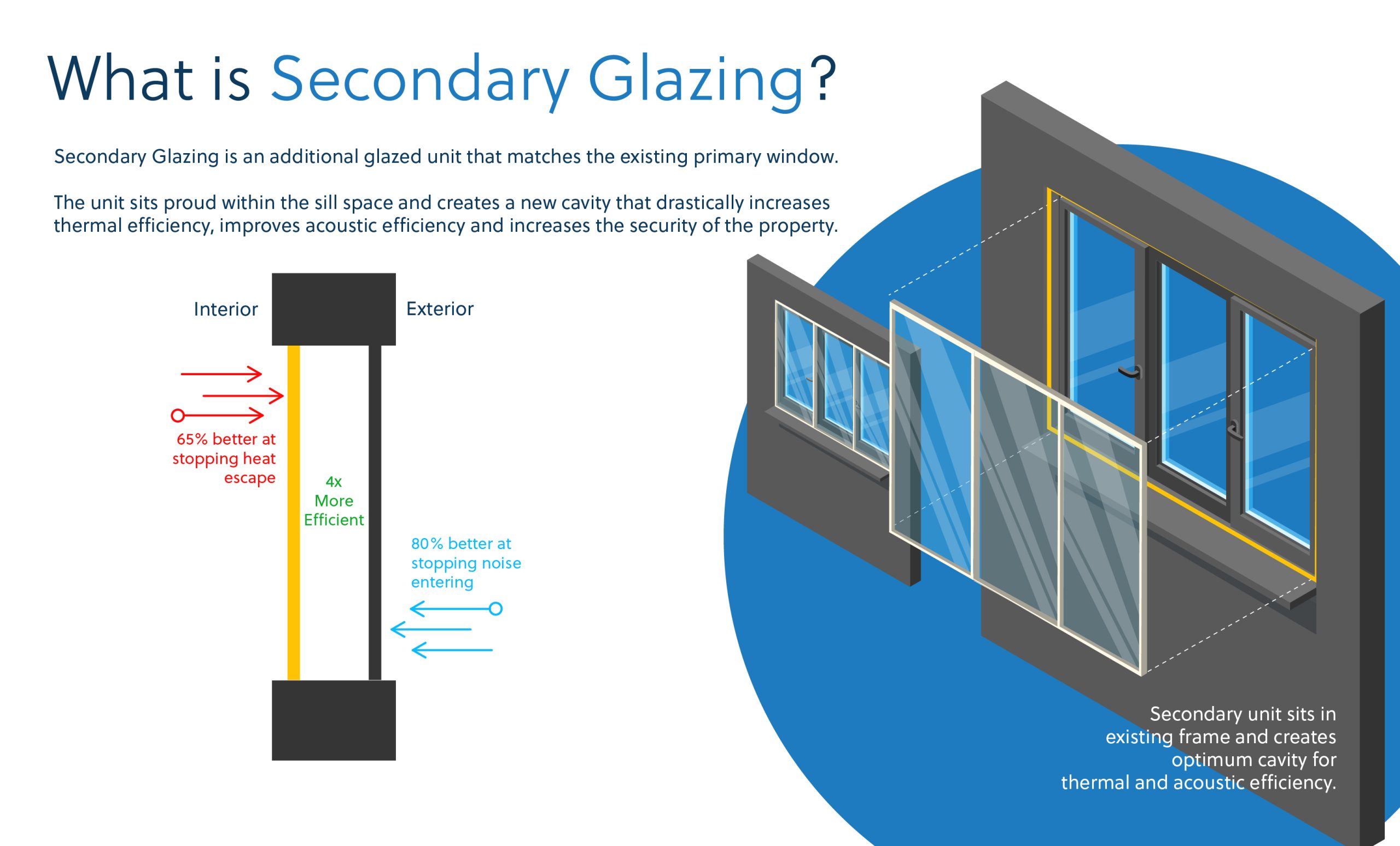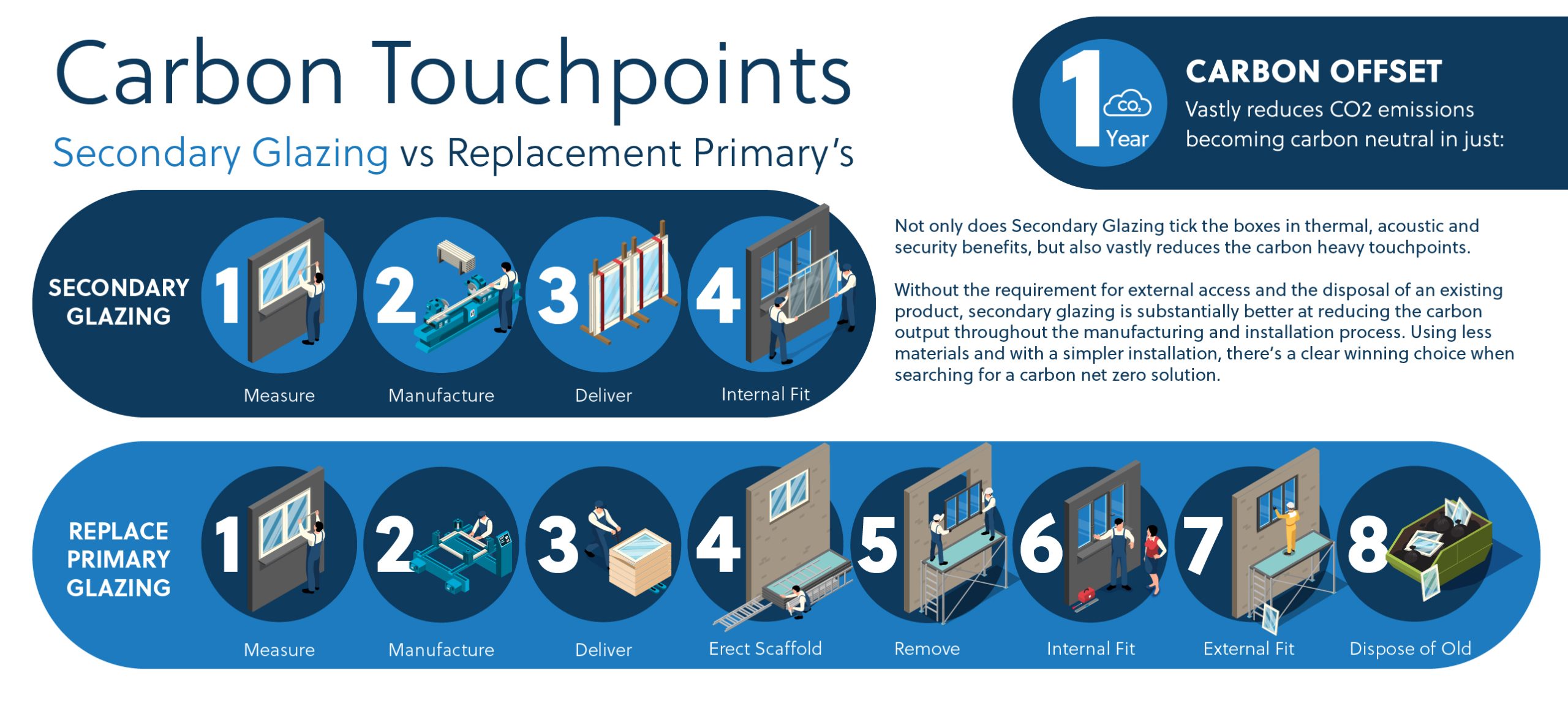Elevating Home Comfort: Secondary Glazing vs Triple Glazing
As the weather becomes brisk, our thoughts often turn to keeping warm. The designated guardian of the thermostat will eventually relent after everyone’s wearing a jumper, thick socks and a dressing gown. Then once the energy bill comes through, the heating goes off and everyone gets into even thicker jumpers!
Triple glazing is gaining traction in the media and it’s easy to see why. We’ve all heard about the benefits of double glazing, so logically it follows that triple glazing must do more.
What is Triple Glazing?
Triple glazed windows have three glass panes separated by two gaps of around 6mm wide that contain either air or an inert gas, such as argon. Whereas single glazed windows have one pane of glass and double glazing has two.
Triple glazing works in the same way as double glazing; the small gaps between the glass act as an additional barrier making the window more effective against noise intrusion and heat loss.
Adding that third pane of glass will be about 20% more expensive than double glazing, and that’s before you take into consideration the disruption and hassle of removing your old windows!
We at Granada believe that there’s a cheaper and more effective solution to these issues: Secondary Glazing.
What is Secondary Glazing?
Unlike double and triple glazing, secondary glazing fits alongside your existing windows. The gap/cavity between the two panes is also bigger which has an improved impact on both noise reduction and heat retention.
Let’s Talk Numbers
Some of this information is probably old hat for some, but for those new to the world of windows and glazing here’s a more in depth breakdown of what all these figures mean:
Insulation (U-Value): By creating a small gap between the panes of glass, double and triple glazing make it harder for heat to escape and ensures that your property stays warmer. If you’re willing and able to afford argon in the gaps or pay for additional coatings, this can improve the U-Value even further. The lower the value, the less heat passes through.
Secondary glazing is a much more effective barrier that can improve thermal performance by up to 65% and lower energy bills by up to hundreds of pounds each year. The combination of a larger cavity, Low-E glass coating and a well-sealed independent frame ensures minimum air leakage which results in an insulating layer that prevents warmth escaping.
In addition, the trapped air works as insulation and provides draft exclusion. If combined with a heat pump, this can lead to incredible efficiency and a significant reduction in both carbon emissions and energy bills.
This improved insulation reduces the need for heating as much, potentially leading to lower energy bills and saving you a substantial amount of money over the years – particularly relevant in the current cost of living crisis.
Noise Reduction: Due to their heftier construction, triple glazed windows are heavier and thicker than double glazed ones. Typically, the units are around 24mm in width, comprising three 4mm panes and two 6mm cavities. Although that third pane creates more of a barrier to sound waves passing through, it is not necessarily the most effective way to reduce noise in your home – as we’ll discuss below.
The sound reduction of double and triple glazing is approximately the same and also only slightly better than single glazing. With secondary glazing you can achieve a significant noise reduction that will ensure peace and tranquillity in your home or business (at least as far as the volume is concerned.)
As the primary and secondary glazing will have different mass, this will also reduce the resonance of the sound when compared to double or triple glazing. As double and triple glazing do not have the same cavity as secondary glazing, they only reduce the resonance once. This is why double and triple glazing do not vary much in terms of noise reduction.
With secondary glazing’s 54 Db reduction, you effectively eliminate the sounds of railways, traffic and even aircraft. By comparison, a 35 Db reduction will only keep out nearby conversations.
Security: Anyone who’s been a little too enthusiastic with a football knows the sound of shattered windows. The more layers, the harder it is to break through. Where secondary shines above all other offerings is adding layers of difficulty to the process.
Thieves will have effectively two windows to break through which is enough to put off almost all opportunists. Combining this with the fact that secondary glazing uses resilient aluminium frames and toughened glass, it means that would-be intruders will have a serious challenge on their hands.
At Granada, we also have options for PAS24 to offer that additional guarantee of safety and security.
Light Transmittance: As light travels through transparent materials (ie glass) some of the light frequencies are absorbed and less light makes it through to the other side. The more glass in the way of light, the less light will get through.
This is further amplified by the way that glass is treated, meaning that some triple-glazed windows can have a light transmittance of 0.4 or lower. This has a notable impact on the brightness of a room especially when compared to double-glazed and secondary glazing.
We’ve been saying secondary glazing was a bright idea for years!
The right product for the job
Beyond the already listed reasons, there are a multitude of reasons why double or triple glazing may not be an option for your property.
Carbon Neutral Retrofit: Our secondary glazing is carbon neutral within one year of installation. By keeping your existing primary windows, you can keep your carbon emissions lower while still enjoying the improved benefits for comfort and security. This can be a large contributing factor for anyone seeking a BREEAM certification for their property. Plus a side benefit is that you don’t need to erect any scaffolding outside your property while it’s being installed!
Conservation: If your property is a listed or heritage building or otherwise requires its original features to stay the same, installing secondary glazing is the best solution. Modern slimline frames will be practically invisible from the outside and fit in seamlessly with the internal design with minimum disruption.
Costs: There are some occasions where triple-glazing will be a fantastic addition to your property. As far as glazing solutions go, you’ll only start to see the benefits if you change all of your windows which can be quite a hefty cost. Cheaper energy bills are a bonus, but sometimes it can be years before you break even on the expense.
For an affordable, high-performance option to improve your thermal insulation, noise cancelling and security, secondary glazing is an incredible solution for you.
Get in touch with our friendly team at Granada Secondary Glazing to discuss your project.


